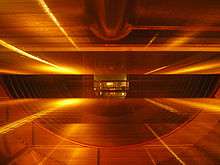UA1 experiment


The UA1 experiment was a high-energy physics experiment that ran at CERN's Super Proton Synchrotron (SPS) accelerator-collider from 1981 until 1993. The discovery of the W and Z bosons by this experiment and the UA2 experiment in 1983 led to the Nobel Prize for physics being awarded to Carlo Rubbia and Simon van der Meer in 1984. Peter Kalmus and John Dowell from the UK groups working on the project were jointly awarded the 1988 Rutherford Medal and Prize from the Institute of Physics for their outstanding roles in the discovery of the W and Z particles.
It was named as the first experiment in the CERN "Underground Area" (UA), i.e. located underground outside of the two main CERN sites at an interaction point on the underground SPS accelerator which was modified at the same time to convert it into a collider. The UA1 central detector was crucial to understanding the complex topology of proton-antiproton events. It played a most important role in identifying a handful of Ws and Zs among billions of collisions.[1]

The UA1 was a huge and complex detector for its day. It was designed as a general-purpose detector.[2] The detector was a 6-chamber cylindrical assembly 5.8 m long and 2.3 m in diameter, the largest imaging drift chamber of its day. It recorded the tracks of charged particles curving in a 0.7 Tesla magnetic field, measuring their momentum, the sign of their electric charge and their rate of energy loss (dE/dx). Atoms in the argon-ethane gas mixture filling the chambers were ionised by the passage of charged particles. The electrons which were released drifted along an electric field shaped by field wires and were collected on sense wires. The geometrical arrangement of the 17000 field wires and 6125 sense wires allowed a spectacular 3-D interactive display of reconstructed physics events to be produced.[3]
The UA1 (Underground Area 1) detector was conceived and designed in 1978/9, with the proposal submitted in mid-1978.[4]
See also
References
Further reading
- "UA1 magnet sets off for a second new life". CERN Courier. 13 March 2008.
- "The W and Z Particles: A Personal Recollection". CERN Courier. 1 April 2004.
- "Neutral currents and W and Z: a celebration". CERN Courier. 9 December 2003.
- image of- UA1 detector
- image of-central part of UA1 detector
The-central